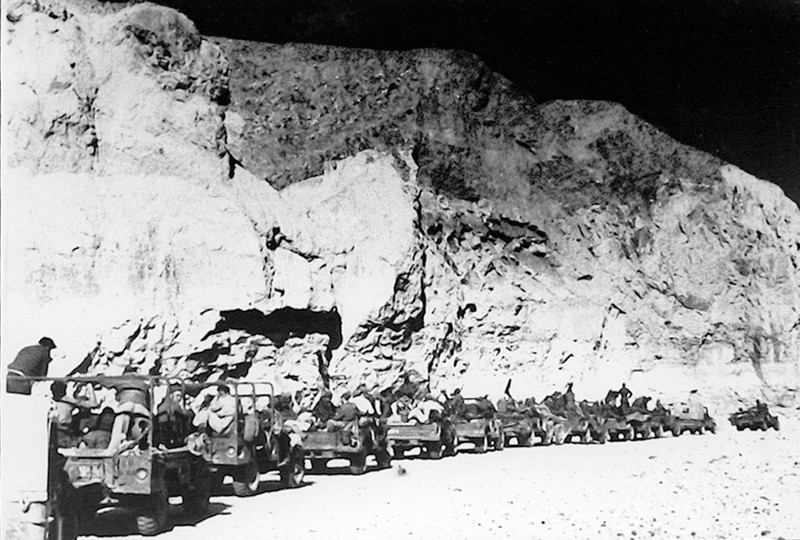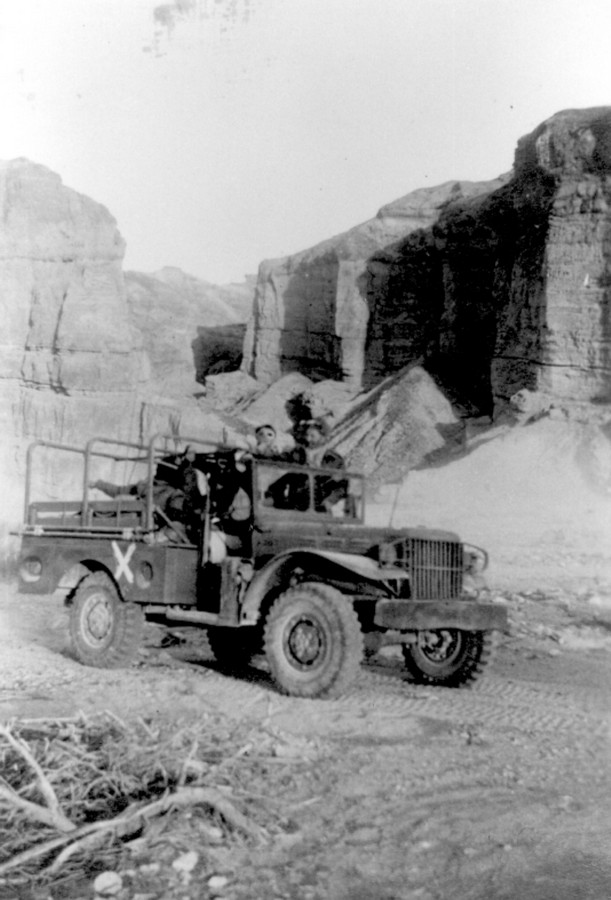Operation "Ovda"
During the negotiations held in Rhodes, the Jordans insisted on keeping the southern Negev and the coast of Um-Rashrash under their domain. Their claim was supported by the British who shared a mutual defense agreement with Jordan and manned high command positions in the Trans-Jordan army. According to the UN division plan, the southern Negev was part of the state of Israel. The operation was planned according to the open fire restrictions as dictated by the Prime Minister and Minister of Defense, David Ben- Gurion, in order to prevent British involvement.
Two Brigades were to move in a pincer movement- 'Golani' Brigade was to move via the Arava, depending on maneuver and rifle blocking; The 'Negev' Brigade was to move via the Negev Mountains, towards Ras-El-Naqeb. The operation scheduled for the 5th of March went according to plan, ending on the 10th of March with 'Negev Brigade forces waving the ink flag in Um-Rashrash. This was the last operation of the War of Independence.
Two Brigades were to move in a pincer movement- 'Golani' Brigade was to move via the Arava, depending on maneuver and rifle blocking; The 'Negev' Brigade was to move via the Negev Mountains, towards Ras-El-Naqeb. The operation scheduled for the 5th of March went according to plan, ending on the 10th of March with 'Negev Brigade forces waving the ink flag in Um-Rashrash. This was the last operation of the War of Independence.
The Negev Brigade - 8
The Negev constituting half of the west of Israel, was never overly populated, but has many quarries, Um-Rashrash located in the south, constitutes a naval passage way to the eastern countries, all of which play a major part in the Zionist vision.
On the 29th of November, 1947, The UN resolution stated that the entire Negev, including Um-Rashrash and the Red sea coast was to be part of the Jewish state. The area occupied by the Jordan Legion was reoccupied during operations 'Lot' and 'Horev' and the road to the southern Negev was reopened, while the Jordan Legion continued to patrol Mt. Negev.
The British held a few camps along the Suez Canal, established the Arab legion, later to become the Jordan legion, and manned the high command positions. Britain who had a mutual defense agreement with Jordan wanted the southern Negev to be annexed to Jordan.
Britain used diplomatic channels in order to look after its interests during operations 'Lot' and 'horev' and sent combat planes to patrol our forces in Sinai, which were gunned down by the young Israeli Air Force; an infantry Battalion reinforced by tanks and artillery was sent to Aqaba immediately after operation 'Horev'. On the 7th of January a cease fire ended operation 'Horev' and Yigal Alon, southern front Commander ordered ground and air patrols of Mt. Negev towards the end of January. The southern Negev occupation plans were introduced to General Staff on the 4th of February and confirmed on the 9th of February. A cease fire agreement was signed between Israel and Egypt and Israel and Jordan had opened negotiations, following operation 'Horev'. It became urgent to claim the territory when Jordan demanded domination over the southern Negev. Prime Minister and Minister of Defense, David Ben- Gurion restricted the plan: crossing of the Egyptian and Jordanian borders was forbiden; use of weapons was forbidden; our forces were to retreat in case of British intervention. Yigal Alon managed to authorize the use of weapons for the purpose of self defense.
The southern Negev was remote and secluded back then, the Arava road leading to Um-Rashrash was mostly made of dirt while certain sections were made of sand and others were paved by stream pebbles. Another road led from Nizana, through Egyptian territory, to the Ras-El-Naqeb cliff and through the mountains to Um-Rashrash. A torrid and desolate territory, comprised of mountains, canyons cliffs and wide Wady's lay between the 2 roads, its scale on the map was 1:250,000 and on temporary black and white maps 1:100,000. A few paths were marked by the Oil Company.
The Israeli delegation to Rhodes dragged the cease fire negotiations with the Trans-Jordan delegation, while the preparations for the operation, including patrol, planning and logistics were carried out on a tight schedule.
On the 20th of February, 1949, Professional Air Force, southern front H.Q., 'Negev' Brigade Officers and 9th Brigade scouts joined the Mobil patrol that left for Mt. Negev.
On the 3rd of March they returned to Be'er-Sheba and on the 5th of March the operation commenced, according to plan.
On the 10th of March all goals were achieved: Mt. Negev, the Arava road, Um-Rashrash, Ein-Gedi and Masada were occupied by the I.D.F.
The operation was carried out according to plan: 2 branches laid siege to the Red-Sea bay. The eastern branch advanced to Um-Rashrash via the Arava road, occupying army posts along the way; while the western branch advanced through a non hostile territory, overcoming obstacles along the road itself. The advance of the forces operating at the same time was not pre-coordinated.
The assignments of the reinforced 'Negev' Brigade Mobil Battalion advancing via Mt. Negev were to occupy the Hamadot territory, west of Wadi Uqfi, 50 km north of Um-Rashrash; pave a landing strip for cargo craft, and establish a camp that would receive provisions and reinforcements; prevent the Jordanians from arriving from the Jardanel police station; a special Company landed in the airfield was to occupy Ras-El-Naqeb cliff.
The Eastern branch, including 2 Mobil Battalions supported by half-tracks, armored vehicles, anti-tank cannons and an engineering force from the 'Golani' Brigade advanced along the Arava road. Their assignment was to move along the Arava road, drive the enemy from its army posts, while disconnecting the posts from the main camps without using weapons. The 'Golani' Brigade was to draw the enemy's attention, thus allowing the western branch to operate freely. Alexandroni Brigade was to occupy Ein-Gedi, while other forces were to maintain 7 army posts along the Daharia bridge- Arad- Ein-Gedi line.
On the 29th of November, 1947, The UN resolution stated that the entire Negev, including Um-Rashrash and the Red sea coast was to be part of the Jewish state. The area occupied by the Jordan Legion was reoccupied during operations 'Lot' and 'Horev' and the road to the southern Negev was reopened, while the Jordan Legion continued to patrol Mt. Negev.
The British held a few camps along the Suez Canal, established the Arab legion, later to become the Jordan legion, and manned the high command positions. Britain who had a mutual defense agreement with Jordan wanted the southern Negev to be annexed to Jordan.
Britain used diplomatic channels in order to look after its interests during operations 'Lot' and 'horev' and sent combat planes to patrol our forces in Sinai, which were gunned down by the young Israeli Air Force; an infantry Battalion reinforced by tanks and artillery was sent to Aqaba immediately after operation 'Horev'. On the 7th of January a cease fire ended operation 'Horev' and Yigal Alon, southern front Commander ordered ground and air patrols of Mt. Negev towards the end of January. The southern Negev occupation plans were introduced to General Staff on the 4th of February and confirmed on the 9th of February. A cease fire agreement was signed between Israel and Egypt and Israel and Jordan had opened negotiations, following operation 'Horev'. It became urgent to claim the territory when Jordan demanded domination over the southern Negev. Prime Minister and Minister of Defense, David Ben- Gurion restricted the plan: crossing of the Egyptian and Jordanian borders was forbiden; use of weapons was forbidden; our forces were to retreat in case of British intervention. Yigal Alon managed to authorize the use of weapons for the purpose of self defense.
The southern Negev was remote and secluded back then, the Arava road leading to Um-Rashrash was mostly made of dirt while certain sections were made of sand and others were paved by stream pebbles. Another road led from Nizana, through Egyptian territory, to the Ras-El-Naqeb cliff and through the mountains to Um-Rashrash. A torrid and desolate territory, comprised of mountains, canyons cliffs and wide Wady's lay between the 2 roads, its scale on the map was 1:250,000 and on temporary black and white maps 1:100,000. A few paths were marked by the Oil Company.
The Israeli delegation to Rhodes dragged the cease fire negotiations with the Trans-Jordan delegation, while the preparations for the operation, including patrol, planning and logistics were carried out on a tight schedule.
On the 20th of February, 1949, Professional Air Force, southern front H.Q., 'Negev' Brigade Officers and 9th Brigade scouts joined the Mobil patrol that left for Mt. Negev.
On the 3rd of March they returned to Be'er-Sheba and on the 5th of March the operation commenced, according to plan.
On the 10th of March all goals were achieved: Mt. Negev, the Arava road, Um-Rashrash, Ein-Gedi and Masada were occupied by the I.D.F.
The operation was carried out according to plan: 2 branches laid siege to the Red-Sea bay. The eastern branch advanced to Um-Rashrash via the Arava road, occupying army posts along the way; while the western branch advanced through a non hostile territory, overcoming obstacles along the road itself. The advance of the forces operating at the same time was not pre-coordinated.
The assignments of the reinforced 'Negev' Brigade Mobil Battalion advancing via Mt. Negev were to occupy the Hamadot territory, west of Wadi Uqfi, 50 km north of Um-Rashrash; pave a landing strip for cargo craft, and establish a camp that would receive provisions and reinforcements; prevent the Jordanians from arriving from the Jardanel police station; a special Company landed in the airfield was to occupy Ras-El-Naqeb cliff.
The Eastern branch, including 2 Mobil Battalions supported by half-tracks, armored vehicles, anti-tank cannons and an engineering force from the 'Golani' Brigade advanced along the Arava road. Their assignment was to move along the Arava road, drive the enemy from its army posts, while disconnecting the posts from the main camps without using weapons. The 'Golani' Brigade was to draw the enemy's attention, thus allowing the western branch to operate freely. Alexandroni Brigade was to occupy Ein-Gedi, while other forces were to maintain 7 army posts along the Daharia bridge- Arad- Ein-Gedi line.
















